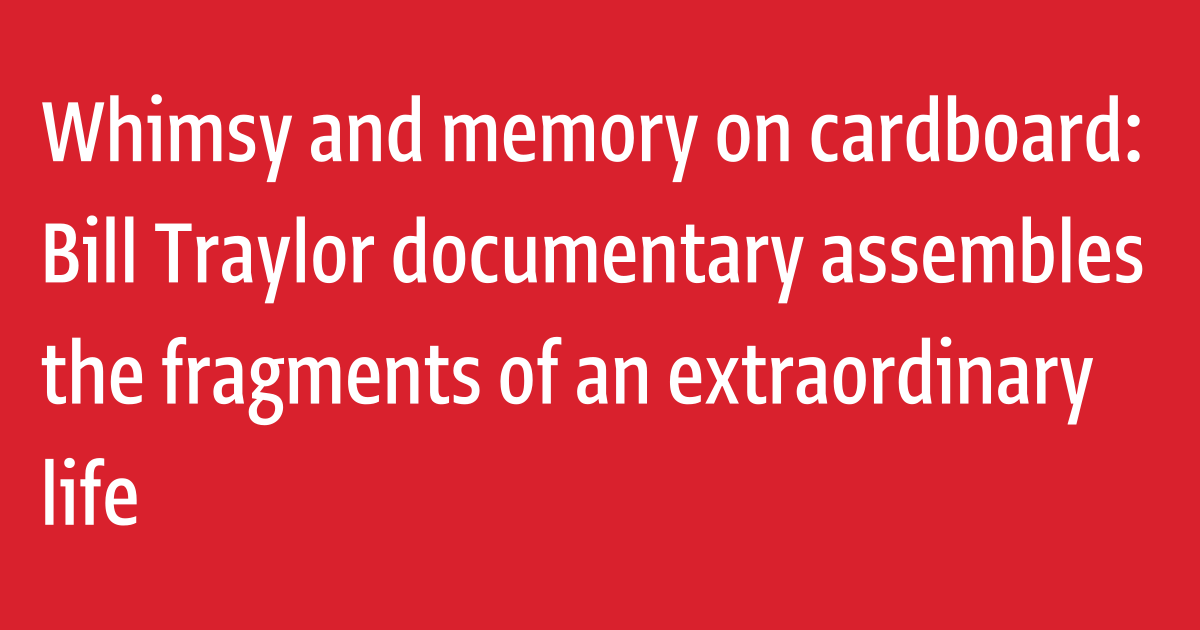ART WORLD NEWS
Whimsy and memory on cardboard: Bill Traylor documentary assembles the fragments of an extraordinary life
Bill Traylor started drawing in his 80s, after a lifetime working on the farms his family lived on since slavery
Photo: Albert Kraus. Collection Tommy Giles Photographic Service
The documentary Bill Traylor: Chasing Ghosts opens with a quotation from Vincent van Gogh, suggesting that people often live unaware of the artists among them. That could be said about Bill Traylor (around 1853-1949), who was born a slave and made pictures in his 80s on the sidewalks of Montgomery, Alabama. The film-maker Jeffrey Wolf explores Traylor’s personal and often playful iconography of animals, people and farm tools, in a blend of choreographed forms, earthy spirituality and satire. A parallel visual line in the film moves through Traylor’s life and land, with archival photographs and film footage, from the last years of slavery in central Alabama, into the Civil War, and eventually into the segregated Jim Crow South. Two on-screen narrators join members of Traylor’s family to bridge gaps where the documentation falls short, which is almost everywhere. The hybrid style fits a story of assembled fragments. Traylor, whose work is now collected around the world, spent most of his working life as a farmer, and did not leave Alabama until he visited his daughter in Detroit, when he was 86.
He drew the world around him with poster paint and pencils (which he also sold), on cardboard collected from the streets. His creatures and his human figures interact in what can look like fables—sometimes charming in their framing of kinetic family life (finding affinities with Chagall), sometimes depicting lynching and other horrors with silhouettes from a darker past that prefigure Kara Walker. A recurring slim comic figure with a hat surrounded by children was probably Traylor himself. Men and women in proud poses are involved in everything from courtship to quarrels. Although many of the Traylor drawings have a muted palette, further muted by pencil shading, colour photographs taken at the end of Traylor’s life show how bright his later painted works could be. Traylor turned to drawing in his 80s. After leaving the farms where he and his family worked since slavery (and were given the name of their owners), he made shoes in a Montgomery factory, repairing relatives’ footwear at night. Later, he set up on the sidewalk drawing pictures; homeless, he slept in an undertaker’s mortuary. Even with some recognition, he died penniless, with one leg amputated, in a segregated hospital.By 1939, Traylor had gained the attention of a local artist, Charles Shannon, who mounted his first show. None of the works sold, but a newspaper called his pictures “remarkably similar to the rock paintings and cave drawings of Africa. His work is completely free from the influence of any formal training in art.” “His work is done in many mediums,” the writer noted, “all as refreshingly spontaneous as the negro spirituals.”
Bill Traylor, Untitled (Chase Scene)
That underestimated work was also undervalued. We learn that Alfred Barr of New York’s Museum of Modern Art offered $1 and $2 for paintings when Shannon brought them to the museum. Shannon rejected the offer. Traylor’s drawings went largely unnoticed until the 1970s, yet the documentary focuses more on the life that Traylor himself lived than on his later “discovery” by museums and the market. Critics who speak admiringly of Traylor in the documentary (Greg Tate, Roberta Smith) also avoid the condescending term “outsider art”. The film distills a broader story also told in Between Worlds: The Art of Bill Traylor, the exhaustive 2018 retrospective at the Smithsonian American Art Museum, curated by Leslie Umberger, who also speaks in the film. On screen, she echoes an observation in the exhibition catalogue: “Determined to shape a visual language for and by himself, Traylor became a master of freeze-frame animation and condensed complexity. His pictures comprise an oral history recorded in the only language available to an illiterate man – a pictorial one.” On his death in 1949, Traylor left piles of drawings in Montgomery with his daughter, Sarah. When she died in 1974, those works were lost when her landlord threw her belongings in the trash. That loss is another reason why the fragmentary Bill Traylor: Chasing Ghosts suggests a portrait that will never be completed. • Bill Traylor: Chasing Ghosts (75min), directed and produced by Jeffrey Wolf, is now playing at Film Forum in New York. Find out more about the documentary at billtraylorchasingghosts.com
Source link













